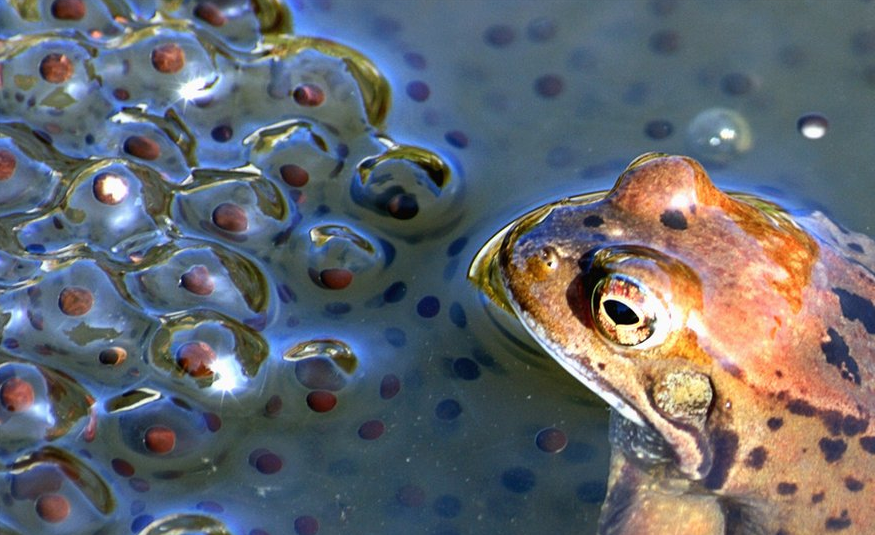Getting children involved in the planning, building and up keep of a garden pond will stimulate their minds and draw their attention closer to nature. Technology is here to stay but if we allow it to dominate our lives out of work and study time we risk losing site of what is around us. We owe it to ourselves, our children and all those who follow thereafter to nurture nature as best we can. As the human population increase in numbers year on year, we further encroach on our natural environment which has devastating consequences The humble garden pond often goes unnoticed, but is a vital source of water and nutrition for wildlife in urban environments.
Dr Jeremy Biggs, director of the Freshwater Habitats Trust (FHT), explains: “Half of the UK’s ponds were lost in the last century. There are approximately half a million in England, Scotland and Wales and 80 per cent of these are in a poor condition and getting worse. A garden pond provides a fantastic way to get really close to wildlife and is a great way of engaging children in nature”
Building a garden pond does involve an element of physical labour, but the whole process should be seen as a fun project. The digging of the pond can unearth all sorts of interesting creatures and treasures and once the water is in your pond it is only a matter of minutes before a host of creatures start to visit. Frogs, damselflies and water beetles are attracted to even the smallest of ponds so you and your children can indulge yourselves in this nature inspiring hobby. The third aspect of getting closer to nature is the collecting of rainwater to fill your pond (a mesh over the pipe will stop unwanted debris entering the rainwater butt and then into your pond).
Tips and steps to building your dream garden pond
Children can get involved right from the start with each stage requiring careful planning. The best time to build a garden pond is either Autumn or the start of Spring when the ground is damp and therefore easy to dig.
Here are the key steps to building a pond to completion.
- Start by investing in a rainwater harvesting barrel and connect to a drainpipe so that by the time your pond is ready to be filled you can do this using the harvested rainwater. Tap water contains too much nitrogen and phosphorous which can be harmful to wildlife.
- Decide where you are going to site your garden pond remembering the it will need at least 6 hours sun per day i.e. can’t be in the shadow of a tree or building for the majority of the day.
- Prepare the site by using a hosepipe or thick rope to mark out the shape of your garden pond. When you are happy with your pond design, use spray paint to mark the grass along the shape created using the rope.

- Start digging by first lifting the grass and then dig down to the desired level including planting shelves and at least one sloping edge to your pond. We highly recommend a sloping edge is included to assist wildlife visiting your water feature to be able to get out with ease. Last month there was an interest article in the Telegraph about why Starlings are mysteriously drowning in garden ponds. Conservationists believe the “inexperience” of young birds in negotiating water could be the reason and as such have suggested homeowners supply sloping exits or ramps in water features so they can get in and out safely. Ponds are an important source of water for birds – particularly during the summer months so providing water sources such as ponds is still recommended as a way to support garden wildlife. Ref: Starlings-mysteriously-drowning-en-masse-in-garden-ponds.
- Clear your pond foundation of stones and gravel and use a spirit level to check the the bottom is flat.
- Install a protective underlay before the pond liner – the underlay will shield your pond liner from being punctured by stones pushed up through ground movement.
- Lay the stone edging to secure your pond liner in place. Following on from point four, you may want to create a beach area to part of your pond edging for easy entry and exit – lay pebbles and sand interspersed with plants to offer protection from the sun and predators.
- Plant with aquatic plants to provide shelter and shade for wildlife.
Then sit back and watch nature take over. In Spring take a close look for frogspawn and watch how they swell and wriggle as the tadpoles move about.
There are three key aspects about building and caring for a garden pond that bring children closer to nature – the understanding of how to use all natural resources (harvesting rainwater and using the grass dug-up to stack one above the other to compost and dig back into the garden beds), creating a water source that attracts wildlife and then watching wildlife thrive in your garden – provide bird feeders and wood piles for frogs and other creatures when hibernating. If you live in the right area you maybe lucky enough to attract some pretty unusual wildlife, from great crested newts to even water voles – keep a look out!






Hmm it seems like your website ate my first comment (it was super long) so I guess I’ll just sum it up what I had written and say, I’m thoroughly enjoying your blog. I as well am an aspiring blog blogger but I’m still new to the whole thing. Do you have any tips for rookie blog writers? I’d genuinely appreciate it.
Great internet site! It looks really good! Keep up the good work!
Juan Riquelme http://board.mt2story.ae/index.php?page=User&userID=83697
Great looking web site. Assume you did a great deal of your ownyour very own html coding
Lionel Messi http://dangtimes.com/index.php?mid=board_TvZF18&document_srl=3828534
Your material is quite important
Harry Kewell http://www.lazysubmit.com/articles/87482-top-ten-music-tracks-2006